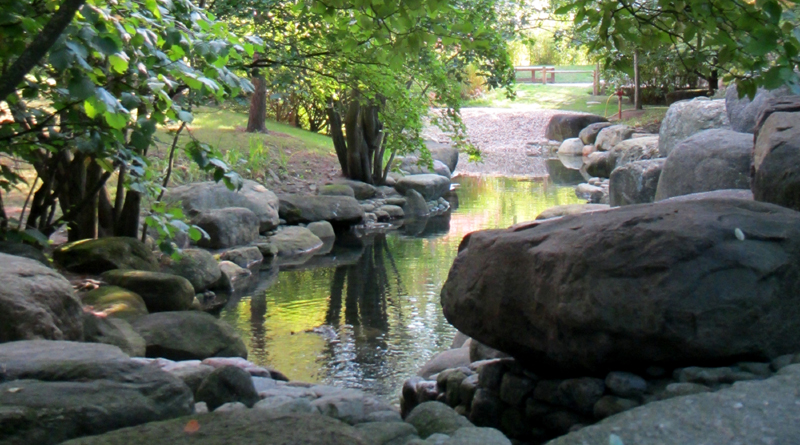GORGEOUS GREEN SPACES IN BERLIN
Did you know that Berlin has over 2,500 public parks, covering a total-surface of approx. 6,400 ha of the city?
No, neither did I.
So far I have only managed to scratch the surface in terms of visiting these parks, but there are two I can heartily recommend; The Gardens of the World, and The Botanical Gardens.
The Gardens of the World
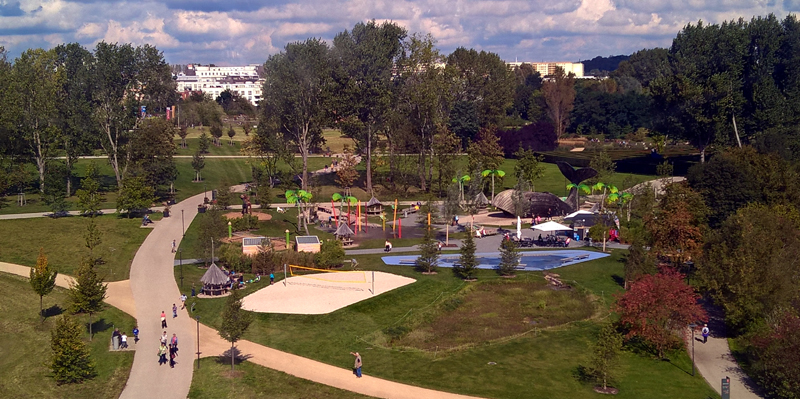
The Gardens of the World, originally the Marzahn Recreational Park, was opened by the East Berlin city government in 1987 to commemorate the city’s 750th anniversary.
It includes a number of themed gardens including Japanese, Balinese, Middle Eastern, Korean, and Christian, as well as the beautiful Italian Renaissance Garden and the Chinese Garden of the Recovered Moon.
The entire park, which covers around 43 hectares, allows you to stroll from one part of the world to the next and experience the way different cultures approach garden design.

There is a newly opened typically English cottage garden (with a tea room, of course), thatched cottage, roses and perennials, an orchard meadow, and spacious lawns. No English garden would be complete without a lawn!
The Balinese Garden is inside a hothouse recreating the humidity of the plants’ natural environment. Brightly coloured flags and strips of silky fabric stand out amongst the shiny dark green of the plants.
In the Japanese garden tiny stones have been raked to mimic the flow of water and encourage quiet contemplation. The design idea of “Garden of merging waters” is based on a symbolic concept of past and future that uses water as a ‘guiding principle to illustrate true harmony among people’.
The Korean Garden, with its striking abstract figures, was initiated during a visit to Berlin by the mayor of Seoul. The aim was to help further deepen the friendly relationship between the South Korean capital and Germany. The garden has open spaces and courtyards, called “Ma-Dang”, a pavilion, and a section that mirrors Korea’s natural rocky landscape with its typical vegetation. There are four walled courtyards, each with differently designed gates, and a pavilion built on rocks at the water’s edge.
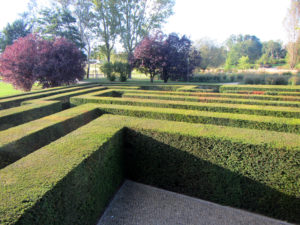 The Gardens of the World also channels Hampton Court; with a maze modelled on the famous palace garden maze, which is considered to be one of the oldest in Europe. Around 750 metres of two-metre-high yew hedges have been planted to create a complex system of paths with plenty of dead-ends to keep you guessing as you work your way towards the centre. The 1,225 evergreen English yews (Taxus baccata) have to be regularly cut to maintain the maze’s geometric form.
The Gardens of the World also channels Hampton Court; with a maze modelled on the famous palace garden maze, which is considered to be one of the oldest in Europe. Around 750 metres of two-metre-high yew hedges have been planted to create a complex system of paths with plenty of dead-ends to keep you guessing as you work your way towards the centre. The 1,225 evergreen English yews (Taxus baccata) have to be regularly cut to maintain the maze’s geometric form.
Dotted throughout the 43ha park are large metal, reclining deckchairs. So, if you fancy a break, lie back and let the sun warm your face as you doze off to the gentle rustle of leaves above you. If the weather doesn’t lend itself to an outdoor nap – then head to one of the pavilions for a snack or cup of coffee.
To get from one end of the park to the other there is a Ropeway. This was built as part of the IGA (International Garden Festival) 2017 and it flies you across the park – giving you a birds-eye view of the greenery below. Each car holds ten people and climbs to a height of around 30 metres. It departs from the main entrance by the U-Bahn station ‘Kienberg – Gärten der Welt’.

The cars’ first stop is the 102-metre summit of Kienberg Hill, near to the ‘Wolkenhain’ observation platform. Hop off here and climb (via the stairs or the handy lift) to the top of the observation tower and soak up the wonderful view of the gardens and the city of Berlin. Then reward yourself with a coffee and cake in the café below.
Hop back on the Ropeway and travel to the central area of the gardens. From here you can visit the different themed gardens and exhibitions.
For more information see: https://www.visitberlin.de/en/garten-der-welt-berlin-gardens-world
and https://gruen-berlin.de/en/gaerten-der-welt/about-the-park
The Botanical Gardens
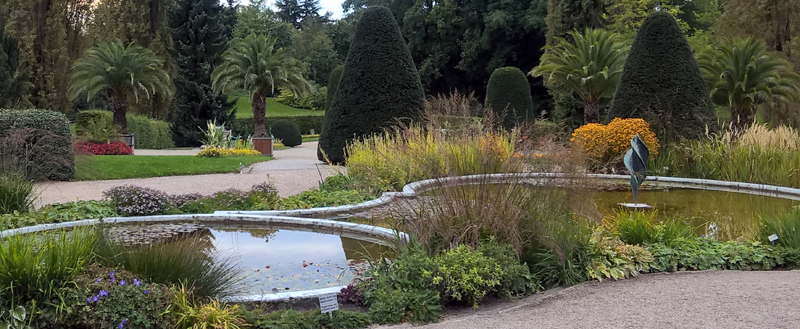 I love Wisely and Kew in the UK – and these gardens in Berlin easily compete. Allow yourself plenty of time to wander along the pathways, sit by the lake, explore the rock gardens, and duck under the low hanging branches to experience the magical kingdom of the Arboretum.
I love Wisely and Kew in the UK – and these gardens in Berlin easily compete. Allow yourself plenty of time to wander along the pathways, sit by the lake, explore the rock gardens, and duck under the low hanging branches to experience the magical kingdom of the Arboretum.
There is an unusual moss garden; created by filling three water basins, abandoned after the reconstruction of the Aquatic and Marsh Plant Garden, with nutrient-poor soil. By placing these in the shade provided by the Beech Forest the perfect conditions are created for the growth of mosses.
Plants from moors, ponds, and coastal areas can also be seen. These plant communities are endangered in Central Europe – as a result of land drainage. Many of the species you can see in the Botanical Garden are threatened by extinction, or have already died out completely in their natural habitats.
Whichever areas you choose to enjoy, the paths are well sign-posted and the map will help you re-orientate yourself if you get distracted by the plants and can’t quite work out where you ended up.
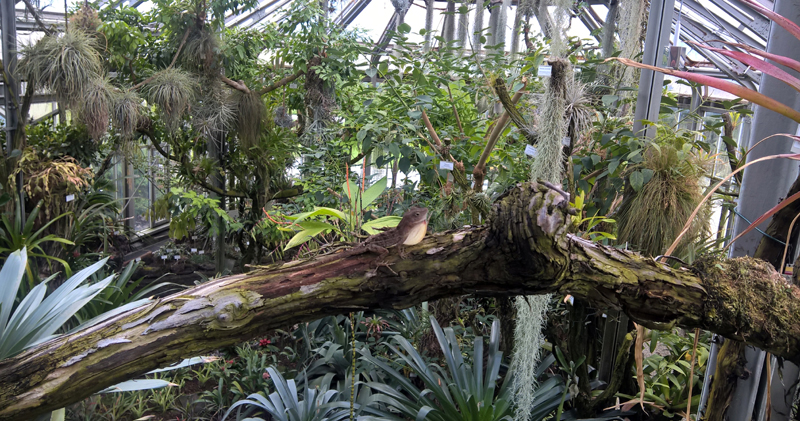
Ultimately head for the giant greenhouses. These are most definitely worth a visit and are organised so that as long as you always turn to your right, you will be taken from the start of the series of glass houses, through each indoor garden, to the very end – and you’ll be sure not to have missed a thing! At the entrance there is an excellent exhibition of underwater plants – these are beautifully displayed with colourful information panels below; it’s easy to forget that below the surface of a pond or river there is another garden, complete its own with plants and animals – a garden we seldom see.
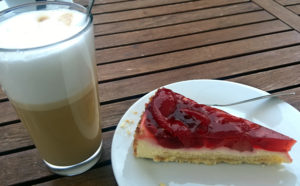 And to round off your day at the Botanical Gardens stop at the café with lovely views over the ornamental pond. Enjoy a coffee and a slice of delicious cake; just what every garden visit needs.
And to round off your day at the Botanical Gardens stop at the café with lovely views over the ornamental pond. Enjoy a coffee and a slice of delicious cake; just what every garden visit needs.
For more information see: https://www.visitberlin.de/en/botanic-garden-and-botanical-museum-berlin-dahlem
and http://www.bgbm.org/en/garden/survey-garden
ABOUT THE AUTHOR
Chantal Cooke is an award-winning journalist and broadcaster with a passion for the planet. In 2002 she co-founded the award-winning radio station PASSION for the PLANET and in 2009 Chantal was awarded London Leader in Sustainability status. Chantal also runs a successful communications agency – Panpathic Communications.

